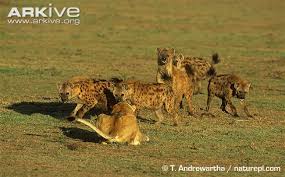Post by dinosauria101 on May 10, 2019 9:15:26 GMT 5
Spotted Hyenas (clan of 5) - Crocuta crocuta
Shoulder height: 70-91 cm (28-36 in)
Body length: 95-166 cm (38-65 in)
Weight: 40.5-81.7 kg (89-180 lb)
General information: The spotted hyena is a species of hyena native to Sub-Saharan Africa. It is the largest member of the Hyaenidae, and is the most social of the Carnivora in that it has the largest group sizes and most complex social behaviours. Its social organisation is unlike that of any other Carnivore, bearing closer resemblance to that of cercopithecine primates (baboons and macaques) with respect to group-size, hierarchical structure, and frequency of social interaction among both kin and unrelated group-mates. Spotted hyena society is matriarchal; females are larger than males, and dominate them. The spotted hyena is a highly successful animal, being the most common large carnivore in Africa. Its success is due in part to its adaptability and opportunism; it is both an efficient hunter and a scavenger, with the capacity to eat and digest skin, bone and other animal waste.

Utahraptor ostrommaysorum
Utahraptor (meaning "Utah's predator" or "Utah thief") is a genus of theropod dinosaurs, including the largest known members of the family Dromaeosauridae. Fossil specimens date to the upper Barremian stage of the early Cretaceous period (in rock strata dated to 126 ± 2.5 million years ago). It contains a single species, Utahraptor ostrommaysorum. The holotype specimen of Utahraptor is fragmentary, consisting of skull fragments, a tibia, claws and some caudal (tail) vertebra. These few elements suggest an animal about twice the size of Deinonychus. Like other dromaeosaurids, Utahraptor had large curved claws on their second toes. One claw specimen is preserved at 22 centimetres (8.7 in) in length and is thought to reach 24 centimetres (9.4 in) restored. The largest described U. ostrommaysorum specimens are estimated to have reached up to 7 m (23 ft) long and somewhat less than 500 kg (1,100 lb) in weight, comparable to a grizzly bear in size. Some undescribed specimens in the BYU collections may have reached up to 11 m (36 ft) long, though these await more detailed study.
:origin()/pre15/b39a/th/pre/i/2017/089/f/9/plunderer_from_utah_by_scotthartman-d2yv4nf.jpg)
Credit to Wikipedia
Shoulder height: 70-91 cm (28-36 in)
Body length: 95-166 cm (38-65 in)
Weight: 40.5-81.7 kg (89-180 lb)
General information: The spotted hyena is a species of hyena native to Sub-Saharan Africa. It is the largest member of the Hyaenidae, and is the most social of the Carnivora in that it has the largest group sizes and most complex social behaviours. Its social organisation is unlike that of any other Carnivore, bearing closer resemblance to that of cercopithecine primates (baboons and macaques) with respect to group-size, hierarchical structure, and frequency of social interaction among both kin and unrelated group-mates. Spotted hyena society is matriarchal; females are larger than males, and dominate them. The spotted hyena is a highly successful animal, being the most common large carnivore in Africa. Its success is due in part to its adaptability and opportunism; it is both an efficient hunter and a scavenger, with the capacity to eat and digest skin, bone and other animal waste.
Utahraptor ostrommaysorum
Utahraptor (meaning "Utah's predator" or "Utah thief") is a genus of theropod dinosaurs, including the largest known members of the family Dromaeosauridae. Fossil specimens date to the upper Barremian stage of the early Cretaceous period (in rock strata dated to 126 ± 2.5 million years ago). It contains a single species, Utahraptor ostrommaysorum. The holotype specimen of Utahraptor is fragmentary, consisting of skull fragments, a tibia, claws and some caudal (tail) vertebra. These few elements suggest an animal about twice the size of Deinonychus. Like other dromaeosaurids, Utahraptor had large curved claws on their second toes. One claw specimen is preserved at 22 centimetres (8.7 in) in length and is thought to reach 24 centimetres (9.4 in) restored. The largest described U. ostrommaysorum specimens are estimated to have reached up to 7 m (23 ft) long and somewhat less than 500 kg (1,100 lb) in weight, comparable to a grizzly bear in size. Some undescribed specimens in the BYU collections may have reached up to 11 m (36 ft) long, though these await more detailed study.
:origin()/pre15/b39a/th/pre/i/2017/089/f/9/plunderer_from_utah_by_scotthartman-d2yv4nf.jpg)
Credit to Wikipedia




